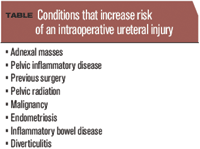Preventing and recognizing urinary tract injuries in pelvic surgery
Urinary tract injuries complicate approximately 1% of all gynecologic procedures, with a ratio of 5 bladder injuries to each ureteral injury. Additionally, urinary tract injuries occur in 0.28% of all cesarean deliveries with a 3-fold risk in repeat cesarean delivery.

Key Points

Urinary tract injuries are rare, but feared, complications. An intraoperative lower urogenital tract injury is a serious problem, but an unrecognized injury is potentially disastrous and extremely dangerous and can have a drastic effect on the quality of life for the patient. It can also be a source of litigation.
Complications of delayed recognition include partial or total loss of renal function, fistula formation, risks involved with additional reparative procedures, and overall poorer outcomes. Primary repair under the same anesthesia at the time of intraoperative diagnosis typically results in a positive outcome. All gynecologic surgeons must understand techniques for prevention as well as intraoperative and postoperative recognition of urinary tract injuries.
Incidence
In the era before the intraoperative use of cystoscopy, bladder injuries were thought to occur during 1.8% of abdominal hysterectomies, 0.4% of vaginal hysterectomies, and between 0.14% and 0.94% of cesarean deliveries.2,3 Ureteral injuries had been reported to be between 0.4% and 2.5% of benign pelvic operations, with only one-third of these injuries thought to be recognized intraoperatively.4
In the late 1990s, the role of intraoperative cystoscopy in detecting ureteral injuries began to emerge. Gilmour and colleagues suggested that many occult injuries were being missed when routine intraoperative cystoscopy was not employed.5 They reported a 4-fold increase in ureteral injuries in studies of gynecologic surgeries using universal cystoscopy (6.2 per 1,000) versus studies not using cystoscopy (1.6 per 1,000). Their data implied that unrecognized ureteral injuries might be more common, remain unrepaired, and be underreported. These findings were supported in a later review of 13 studies of a cumulative 4,146 pelvic operations that used routine cystoscopy, which showed an overall incidence of 5.8 per 1,000 cases.6 No complications of intraoperative cystoscopy were described in any of these studies.
Certain pelvic procedures seem to carry an even higher risk of ureteral injury. A recent analysis by Ibeanu and associates of 839 benign hysterectomies with universal cystoscopy showed the overall incidence of injury to the bladder or ureter to be 4.3%.6 Ureteral injury was detected in 1.8% of hysterectomies, which the researchers identified as higher than previous reports.7-9

